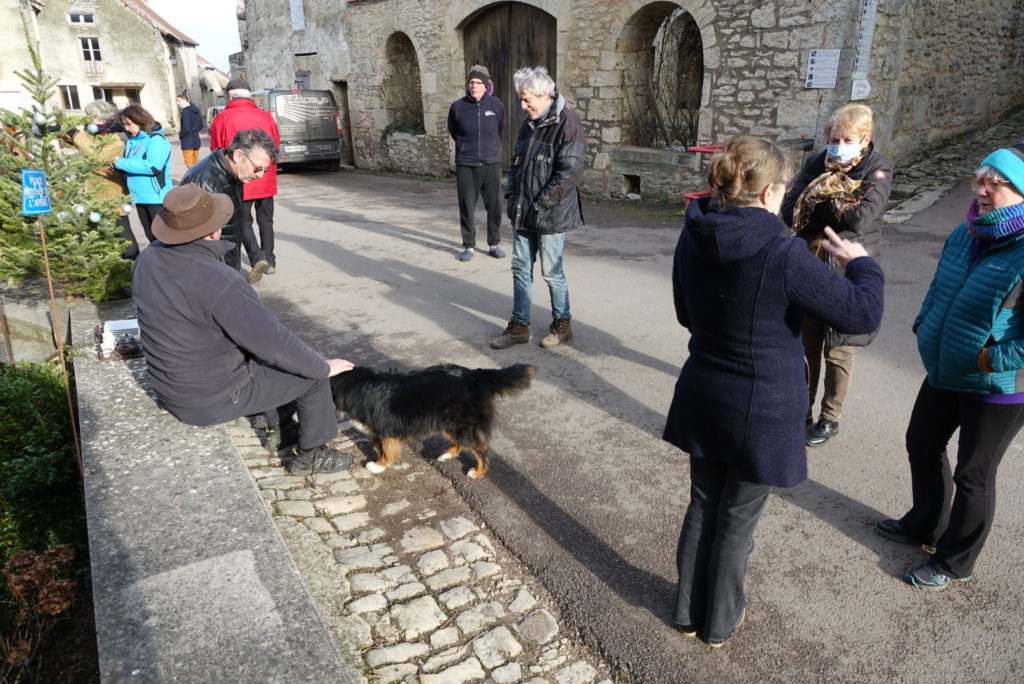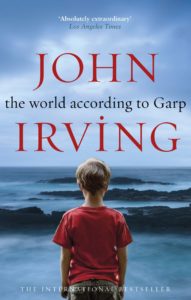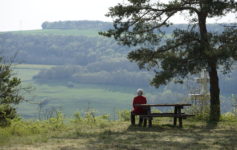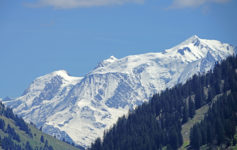
“You know, everybody dies,” Jenny Fields tells her son T.S. Garp in John Irving’s The World According to Garp. “My parents died. Your father died. Everybody dies. I’m going to die, too. So will you.
“The thing is, to have a life before we die. It can be a real adventure having a life.”
One of my favorite things about my favorite novel is that Jenny chooses in all instances to tell the truth, not only to her son, but to the world. In this passage, she is answering her pre-teen son Garp’s question about life and death, and she does so in the only way she knows how: honestly. As the main character of Irving’s epic tale often says, “ In the world according to Garp, we are all terminal cases.”
As an Irishman, born to a melancholic tribe, I am called by ancestry and tradition to spend more than an average amount of time pondering my mortality, and the evanescence of our lives on earth. This natural tendency has certainly been magnified by the fact that both of my parents, and one of my brothers, were dead before they reached the age of 45. Way too soon.
I know this has affected how I live my life. I know it certainly helps to explain why I was willing to quit my job maybe a little too soon, and throw caution to the wind, and move with Paula to France. The clock is ticking, and we’re all going to die. But first, Jenny Fields urges us, we should have a life.
Paula and I came to Europe believing that travel was the highest form of adventure. When we started travelersforlife.com, we were still working, and the sentiment was aspirational more than descriptive. But once we landed in our Burgundian village in the center of France, we set out to make it a way of life. And, with much of Europe, from Venice to Amsterdam, an easy day’s drive away, and with one of the world’s most centrally located global airports an hour’s train ride away, we were doing a pretty good job. France, Italy, the Netherlands, Switzerland, Canada, Japan, Cambodia, Australia, Sweden, Norway, Singapore, Hong Kong, and, of course, the United States were our playgrounds. We were always on the move, and the question our friends in Flavigny most often asked us was, “Where are you going next?”
We weren’t planning on the COVID, but it came just the same, and it all ground to a halt. It has been a strange transition, from carpe diem to Seize the Hand Sanitizer. And now our conversations are not about the trips we’re going to make, but the risks we’re willing to take.
Not too many, as it turns out. And this caution of ours, this willingness to wait out the virus, has engendered many conversations with, and I suspect among, our friends, about how two people seemingly so fearless about seizing life and taking risks (quitting their jobs, selling their belongings, buying a house on a whim, moving to France) are suddenly so risk averse, so seemingly afraid.
COVID is kind of a taxonomic event. It has all of us comparing notes on risk, and gravitating towards those whose profile lines up with our own. Not surprisingly, Paula and I talk about this a lot. We are fortunate to be absolutely in agreement about what we’re willing to do, and what we’re not willing to do. And our views have evolved as knowledge and facts on the ground change. We are not a fixed opinion.
All of that said, I have an expression that I use quite often: “Don’t die stupid.”
What that means is, while having your adventure, don’t do stupid things and take stupid risks. It means do the simple things, like wear your seatbelt when you drive, get that strange mole checked out, wear your bicycle helmet, salt the stone steps when they’re covered in ice, wear your mask in public. And get the vaccine as soon as you can. The goal is to avoid coming to the end of your life and saying, or leaving behind your loved ones to say, “Well, that was stupid!”
For us, that means the closer we get to being able to get the vaccine, the more cautious we become. We have no problem admitting our fear of COVID-19. For us, we have exactly the right amount of respect, the right amount of caution, the right amount of patience. Now that we’re so close to being protected, it becomes even more vital to be careful.
This does not mean that we’ve been isolated since last March, when countries frantically commenced lockdowns. In the ups and downs of COVID-19’s path, we’ve followed the science. As it became clear that outdoor socializing at safe distance was relatively safe, we spent a summer and fall socializing with friends in the beautiful gardens and terraces of Flavigny. It helped to preserve our sanity.
We even traveled this summer. Back in the glorious, sunny days when there were fewer than a couple of hundred new cases a day, we took driving trips to Venice when it was miraculously near-empty, to a chalet in the Swiss Alps, to Mont Blanc in the French Alps (takeout pizza), to Arles in the south of France, and again to Italy, to Lake Como. Always, we wore masks indoors in public. Never did we eat indoors. But neither were we sitting at home doing nothing.
It’s not rocket science that as people started to spend more time indoors together, cases went up, and by late fall the world was on fire again. Then the virus started mutating, and our calculations changed with the pandemic. Still, it wasn’t really until August that we considered ourselves locked down. And it was a couple months more before we had to stop socializing as the weather grew cold. So we’ve really only been isolated and extra-careful for six months or less.
This caution comes at a price. We have dear friends in this village and in others, with whom we have not broken bread in many months. We get invited to lunches and dinners and aperos indoors, which we politely decline. There’s no question we are known as extremely cautious these days. As we like to say, we hope to be teased about this for many years to come.
Some of our friends have made the argument that life is for living, and we can’t stop just because there’s a pandemic. But we don’t really feel like we’re not living. We walk in the beautiful countryside. We Zoom with friends all over the world. We continue our weekly French lessons, also via Zoom. We run into our neighbors on the street. And to the extent that we have stopped living the life we want to live, we kind of think that yes, if the stakes are high enough and closed-ended enough, we can wait it out.
It’s true that there’s an inherent gamble in hunkering down and waiting for the vaccine. Few of us get to choose the time and cause of our passing. So there’s always a chance that while we sit in the house waiting to be vaccinated, we’ll die of something else.
On the other hand, if you’ve been paying attention, you know that COVID-19 is a particularly horrible way to die.
When you crunch all the numbers and stats together – our age, health, country of residence, etc., our chances of dying from COVID if we catch it are somewhere between 2% for Paula and 6% for me (a guy with medication-controlled hypertension). That’s bad enough. But what the death rates don’t capture is the additional risk to COVID survivors of long-term damage.
If we are in the 94-98 percent of people who survive COVID, in our age group we have about a 1 in 10 chance of developing serious, long-lasting complications. We could live the rest of our lives with damaged lungs, or a weakened heart, or a whole host of syndromes and symptoms that define “long-COVID.”
We do understand that there are other risks in the world. But the risks of COVID don’t replace those risks. They are additive to it. We choose to get behind the wheel of a car, even though there is risk. We choose to travel, even though that involves risk as well. But using the same logic, we choose not to add a 12% to 16% additional chance of death or disability, just because we couldn’t wait 10 months for our get-out-of-jail shot.
But that’s math. And it’s easy to use numbers to shield ourselves from the harsh realities of this brutal virus. It’s hard to wrap your head around 400,000 dead (the U.S.) or 82,000 dead (France) or more than 2 million dead (the planet). So we’ve tried to pay attention to the individual stories – the nurse, the doctor, the daughter, the mother, the husband. The individual human lives, the individual broken hearts, the personal loss, multiplied by millions.
And here’s what magnifies the tragedy: most of them died alone, in an overrun hospital ICU, with a tube down their throat, unable to breathe, unable to speak. Unable to feel the companionship and warmth of the people who love them. There are no lovely ways to die. But make no mistake, dying of COVID is an awful way to go. A friend carries a letter in his pocket at all times that says if he ends up in the hospital with COVID, do not under any circumstances put him on a ventilator. He is adamant: Just let him go.
We’ve also known people who’ve ended up in ICU, and gasped their way up to the edge of the abyss. They survived, but they carry the ordeal with them still, and probably forever.
If you let the pandemic in – really let it in, and allow yourself to feel the human cost of it – it can be overwhelming. And sometimes, to be honest, we are overwhelmed. This will be one of the deadliest years in recent human history. When countries finally tally up their “excess death rate” – that is, the additional number of dead above the yearly average of fatalities – we’ll clearly see rates never experienced outside world war. Or the last pandemic.
Recent research from Harvard University found that people in the US who died of COVID-19 lost an average of 13 years of life. Of course, for some it was 40 or 50 years. For others just a few. It averages out, though, to 13 years that people would have been expected to live if they had not gotten the virus. Thirteen years of hugging grandchildren, traveling the world, visiting friends, making love. More than 4,700 sunrises and sunsets.
The loss is shattering and immense.
The fatalists say: “But life goes on. What are you gonna do?” Here’s our answer: Don’t get this virus. Paula and I can expect, by the statistical tables, to live about another 21 years. It’s the blink of an eye. But we both desperately want every moment we can get, and more. We’re willing to pay the cost, tallied in isolation and lost experiences and separation from friends and loved ones, to survive the dangerous crossing from outbreak to vaccine.
That’s the journey we’re trying to complete. And we’re almost there. Of course, there are no guarantees. Of course, you can’t make the risk zero. We know we don’t get to write our own ending.
But we’re determined that COVID won’t get to write our ending, either. And once we’re vaccinated, we can make up for lost time. After all, we are children of New Orleans. We’ve survived worse. And it just means the next party we throw will be that much bigger, that much more full of joy. Give us a little time. We’ll catch up.
The last three years have been the most extraordinary time of our lives. We know how lucky we are to be able to live in this place. And here’s the lesson we didn’t expect: What we treasure most are not the amazing trips we’ve been able to take, but the amazing friends we’ve been able to make. We have more love, more friendship, more kindness in our lives than we ever imagined. And the pandemic can’t take that away from us.
Any journey worth taking brings with it risk, and sometimes fear. But that’s where the learning happens, and Paula and I still have a lot of that to do. We’ll get our vaccinations soon. And then we can get back to cherishing our friends, traveling the world, riding the unpredictable currents of this great, glorious river that is life.
After all, it’s a real adventure having a life.





Well done. I’ve never read the book (Garp), of course I’ve seen the movie years ago. I just put a hold on a copy at our local library….Cheers and congrats on finding ways to live life happily but carefully….
Thanks Bill. Let us know what you think of the book!
Thank you James,
Spot on!
Marvelous summary of the situation and our options. You have written a very nice piece about how you and Paula deal with this reality. I fully agree with your analysis and hope we can all avoid contamination. Indeed we should not stumble just before the finish line.
I admire the way you compose your views and put these to paper.
So STAY SAFE, enjoy every moment, and keep the distance…
Cheers,
Henk